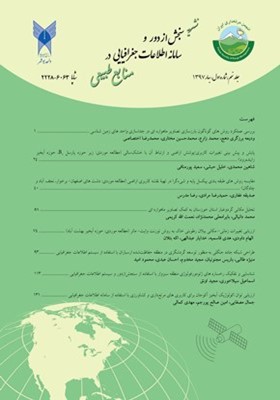ارزیابی توان اکولوژیک آبخیز آکوجان برای کاربری های مرتعداری و کشاورزی با استفاده از سامانه اطلاعات جغرافیایی
محورهای موضوعی : توسعه سیستم های مکانی
جمال مصفایی
1
*
![]() ,
امین صالح پور جم
2
,
مهدی کمالی
3
,
امین صالح پور جم
2
,
مهدی کمالی
3
1 - استادیار پژوهشکده حفاظت خاک و آبخیزداری، سازمان تحقیقات، آموزش و ترویج کشاورزی، تهران
2 - استادیار پژوهشکده حفاظت خاک و آبخیزداری، سازمان تحقیقات، آموزش و ترویج کشاورزی، تهران
3 - کارشناس ارشد آبخیزداری، اداره کل منابع طبیعی و آبخیزداری استان قزوین
کلید واژه: تناسب اراضی, آبخیز آکوجان, ارزیابی چند معیاره, مدل اکولوژیک, مکانیابی,
چکیده مقاله :
ارزیابی توان اکولوژیکی سرزمین، مرحله میانی فرآیند آمایش سرزمین است که طی آن متناسبترین کاربری ها برای یک منطقه تعیین میشوند. لذا انجام این مطالعات، برای دستیابی به توسعه پایدار امری ضروری بوده و نیازمند تحقیق در مکان از دیدگاه های مختلف است. هدف تحقیق حاضر، تعیین توان اکولوژیک اراضی برای کاربری های کشاورزی و مرتعداری و همچنین مشخص کردن نوع و مساحت کاربری های غیرمجاز و خارج از توان اکولوژیک در حوزه آکوجان قزوین است. بدین منظور، ابتدا نقشه طبقات منابع اکولوژیک آبخیز آکوجان شامل بارش، ارتفاع، شیب، اجزاء واحد اراضی (عمق و بافت خاک)، پوشش گیاهی و شدت فرسایش تهیه و از انطباق آنها، نقشه واحدهای همگن زیست محیطی حاصل شد. سپس تناسب هر واحد همگن مطابق با مدل اکولوژیکی کشاورزی و مرتعداری، برای کاربری های کشاورزی و مرتعداری تعیین شد. درنهایت مساحت و نوع کاربری های غیرمجاز با استفاده از انطباق نقشه کاربری اراضی فعلی با نقشه کاربری های حاصل از توان اکولوژیک، استخراج شد. نتایج نشان داد که درمجموع 3188 هکتار (44%) از اراضی سطح آبخیز تحت کاربری های غیرمجاز قرار دارد که سهم کاربری های غیرمجاز دامداری و مرتعداری، کشت و باغات آبی و دیم زارها به ترتیب برابر 2569 هکتار (34.9%)، 211 هکتار (2.8%) و 408 هکتار (5.5%) می باشد. نتایج این تحقیق نشان داد که در آبخیز آکوجان، تفاوت زیادی بین کاربریهای مناسب و کاربریهای فعلی اراضی موجود است که بیانگر میزان انحراف از اصول توسعه پایدار محسوب میشود.
Evaluation of the ecological capability of the land is an intermediate stage of the land planning process, which the most appropriate land uses are determined for an area. So these studies which require investigation in locations from different perspectives are necessary for sustainable development. The purpose of this study was to determine the capability and suitability of lands for agricultural and rangeland uses and also to determine the area of unauthorized land uses of the Aqujan watershed of Qazvin province. The maps of the ecological resources of the watershed (including precipitation, elevation, slope, land units (soil depth and texture), vegetation, and erosion) were prepared and crossing in a GIS environment, the homogeneous environmental map units (work units’ map) were obtained. The ecological potential of watershed lands was determined by comparing the characteristics of ecological homogeneous units with the ecological model of agricultural and rangelands. Finally, the area of unauthorized land uses was determined using overlaying the current land use map and the land use map derived from ecological capability. The results showed that 3188 ha (44%) of the area is occupied by unauthorized land uses. The contributions of unauthorized livestock and range management, irrigated orchards and cultivations, and dry farming land uses were 2569 ha (34.9%), 211 ha (2.8%) and 408 ha (5.5%), respectively. The results of this study showed that there is a big difference between the proper and current land uses in the Aqujan watershed, which indicates the degree of deviation from the principles of sustainable development.
_||_

